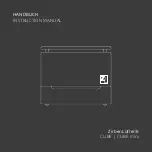
CPC700 User’s Manual—Preliminary
8-9
8.4.6 Extended Status Register Notes
Bit 0 is cleared when the on-deck interrupt is cleared and the pending IRQ has become the on-deck IRQ.
Bit 4 is cleared when the active interrupt is cleared and the on-deck IRQ has become the active IRQ.
Bits 5:7 are automatically cleared when the pending transfer bit is set in the control register. Bits 1:3 are
read-only and change as the bus control state machine sequences. Bits 0, 4, 5, 6, and 7are cleared to a
logic 0 by writing a logic 1.
The bus control state bits (bits 1:3) are a direct encode of the main state machine inside the IIC interface
logic. Their defined values are as follows:
• 0x0 Not used. If this value is read, there is a major malfunction in the IIC hardware.
• 0x1 Slave selected state. The IIC interface enters this state after it detected and successfully decoded
a slave operation on the IIC bus.
• 0x2 Slave transfer state. The IIC interface enters this state after it detected but has not yet decoded a
slave operation on the IIC bus.
• 0x3 Master transfer state. The IIC interface enters this state after it was programmed with a requested
master transfer and it has started a master operation on the IIC bus.
• 0x4 Free IIC bus state. The IIC interface is in this state whenever the bus is free and no pending trans-
fer was requested.
• 0x5 Busy IIC bus state. The IIC interface is in this state whenever the bus is busy.
• 0x6 Unknown IIC bus state. This is the state the IIC interface will enter after its RESET signal was acti-
vated.
• 0x7 Not used. If this value is read, there is a major malfunction in the IIC hardware.
The pending and on-deck interrupts, along with the active interrupt in the status register, form a miniature
FIFO for storing the interrupts. A new interrupt is first set into the pending state. It will stay pending as long
a an on-deck interrupt is present. Once the on-deck interrupt is cleared, or if none was present at the time
the new interrupt occurred, the pending interrupt is moved into the on-deck state. An on-deck interrupt
remains in the on-deck state as long as an active interrupt is present. Once the active interrupt is cleared,
bit 4
Halted or stopped. Set to a logic 1 when a request to halt operations on the IIC bus by the
program was completed. This bit is also set whenever the current requested master transfer
has ended. Normally the requested transfer ends with the issuance of a STOP signal on the
IIC bus, but it can also end with the detection of a loss of arbitration during a read operation.
This bit is cleared to a logic 0 by writing a logic1.
bit 5
Error. This bit is set whenever bits 5, 6 or 7 are set in the extended status register. It is
provided as a summary of the success or failure of the requested master transfer. This is a
read-only bit.
bit 6
IRQ active. When set to a logic 1, an IIC interrupt has been sent to the CPC700 interrupt
controller. The extended status and extended control and slave status registers can be read
to see why the interrupt was set. The interrupt is cleared by writing a logic 1 to this bit. If
interrupts are disabled, bit 5 in the mode control register is logic 0, then this bit, IRQ active,
will not be set.
bit 7
Pending transfer. Control bit 7 is also readable here to help the program, via one read
operation, determine the state of a requested transfer. This is a read-only bit.
Table 86. Status Register (Continued)
Register ‘FF6X_0008’ - Status
Summary of Contents for CPC700
Page 10: ...Table of Contents x Table of Contents...
Page 16: ...Tables xvi List of Tables...
Page 28: ...1 12 CPC700 User s Manual Preliminary...
Page 72: ...3 36 Processor Interface...
Page 132: ...4 60 Memory Controller...
Page 184: ...5 52 PCI Interface...
Page 194: ...6 10 Clock Power Management and Reset...
Page 224: ...8 18 IIC...
Page 244: ...10 10 Interrupt Controller...
Page 246: ...I 11 2 JTAG...
Page 250: ...12 4 Processor Local Bus PLB...
Page 262: ...14 10 Register Summary...
Page 267: ...CPC700 User s Manual Preliminary...
















































